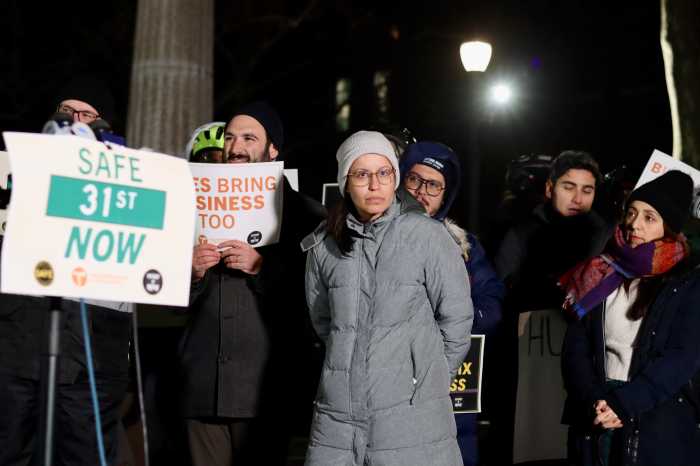By Rashmi Vaish
The very idea of watching almost two hours of the most successful heavy metal band in history just jamming and hanging out seems a bit much. Hasn't the rock world seen its share of rockumentaries glorifying bands? What could possibly be new in this one?
But sit through the first 20 minutes or so of the film, which pretty much just shows the band in a makeshift studio in the Presidio in San Francisco recording “St. Anger” in 2001, and you know that you're in for quite a ride.
In tow is Phil Towle, therapist and performance enhancement coach, who Metallica hired after bassist Jason Newsted abruptly left the band to branch out on his own. Music is recorded and egos clash until vocalist/frontman James Hetfield walks out, slamming the door on his band mates of 20 years. Left wondering are drummer Lars Ulrich, guitarist Kirk Hammet and producer Bob Rock.
At this point the film takes a turn. What was meant to be a promotional clip filmed by Joe Berlinger and Bruce Sinofsky becomes a fly-on-the-wall rendering of band members, present and former, airing their feelings and examining their attitudes in the wake of Newsted's departure, all the while waiting for word from Hetfield who checked himself into rehab at an unknown location.
In a recent interview at the St. Regis Hotel in Manhattan, Hetfield had the opportunity to explain the feelings behind the film, which opened in New York July 9.
“We didn't know we were going to embark on a mid-life crisis, or a maturing of the band or whatever you want to call it,” he said. “You can't plan it. But it happened.”
And its at this point where you meet the real, behind-the-scenes Metallica – grown men, each with aggressive, assertive personalities (except Hammet who likes to be the example of being egoless), fighting, collaborating, bickering, giving their all to create their own brand of music.
The film is striking in the personal journeys it records for each of the band members. And the one man who comes out shining is Hetfield, who seems to have been through the most rigorous personal journey. Its apparent when you meet him face to face. The expectation of meeting the fierce rocker he has been described as is thwarted by a calm openness and seeming humility.
He hedged when asked if there is anything he would change in his past, but after visibly struggling with a very evident instinct to recede he said “I cant say. Because everything has brought us to a different point. And I don't drive. You know, there's a path for me, and a path for everyone, I feel, and they intertwine. (It) happen(s) for a reason and I wouldn't want to change anything because we're here, and we're still here.”
“I guess the only thing I would want to change from my past is my old degrading behavior,” he added. “I've hurt people. And it's affected others, and their lives. And I hope it hasn't been done in such a way that it's really damaged them.”
Too much psych talk for a rocker? Hetfield doesn't care. “This is the best me I can be right now. And you know what? If (people) see something inspirational in that, good. If they see weakness, fine. If they see someone who has addressed demons and become more of a whole person, then good too.”
Having had his reservations about the cameras recording the sessions, “this giant eyeball staring at you,” Hetfield is finally comfortable with what the film portrays.
“People know us as the crazy rocker guys, staunch, mighty Metallica,” he continued. “This is the exact opposite extreme. We don't sit around like this every day and analyze our breakfast. We're somewhere in the middle, that's what life is. But we have to go these lengths to find out where the middle is.”
The moment of Hetfield's leaving for rehab, which was prompted by his wife throwing him out of the house, as he explained later, became a pivotal point for Berlinger and Sinofsky who were hired to shoot a promo.
Said Sinofsky, “See, were storytellers. We didn't know they were going into therapy,” Sinofsky said. “So we walk into this room at the Ritz Carlton and there's Metallica, the biggest heavy metal band of all time, in the middle of a group therapy session. We looked at each other and said, 'Wow, this has potential.' Our instincts as filmmakers really took over.”
It also happened to be a tumultuous time personally for Berlinger and Sinofsky. They were on their way out as a filmmaking team and were having their own “James and Lars” issues, as Berlinger put it, not having made a film together in more than two years. But filming Metallica's sessions prompted them to salvage their own relationship and resolve their differences, something they acknowledge wouldn't have happened without making the film.
And Metallica? History records that they did pull through and hire an ex-Ozzy Osbourne band member, bassist Robert Trujillo, to remain centerstage as heavy metal's number one band. What you get to see is how it came to be. And it very nearly wouldn't have come to be.
The band wouldn't have survived without therapy which was their very last choice, said Hammet. “That whole sex, drugs, rock and roll thing was a choice that just stopped working for us,” Hammet said. “Some people work really hard to attain that, but for us, we had had too much of it and it started working against us. We had to reexamine how we approached everything. Therapy really was our only way that we could see that would really just help us gain any sort of reconnectedness because we were so disconnected at that point. That's probably the reason why Jason left, the communication, the disconnectedness. It had reached a peak where it was starting to take people.”
The film also records how Ulrich took on Napster, becoming one of the most unpopular rockers of the time. “It's the only time – when I see the movie – that I really squirm,” said Ulrich. “I wish that I had known more about what we were getting into. We were really caught, we were ambushed by not being aware of what this meant for people at the grassroots level.”
Ulrich and his bandmates had launched a crusade against the internet-based software group Napster and the users of their software who illegally download and distribute songs without regard to copyright and law.
“The only thing it was about was control,” Ulrich said. “It was never about money, it was never about downloading, it was never about MP3s. It was just about control. I'll shout this from the rooftops till the day I die: We are very controlling about what is Metallica. Because were proud that when we let it out there, people know that its coming from us. We've always had a very selfish kind of thing with that. Once in a while it backfires.”
Ulrich also squirmed when he met up with ex-Metallica guitarist Dave Mustaine, who tried his best to explain the agony of being ex-Metallica.
“I'm glad I wasn't there,” Hetfield said. “It was an extremely revealing scene for both of them. I think Lars finally doesn't know what to do. Lars finally isn't in control and the camera's there.”
Control. It's what most of the band's 20 years were about, you learn. And what you see in the film is their effort to decentralize and democratize – not just their relationships with each other but also in the musical process of the band, when they let other band members chime in with lyrics.
“If you're in Metallica you get to write lyrics as long as I have the last say,” quipped Hetfield.
At the end of it, the monster that is Metallica shows its human side. And as with everything that characterizes Metallica, it's out there, in your face. Like it or leave it. The choice is yours.
“Metallica: Some Kind of Monster” is currently playing at two theaters in Manhattan and will open at the Clearview Manhasset, 430 Plandome Rd. in Manhasset, Friday, July 23. Call 516-365-9188.




































